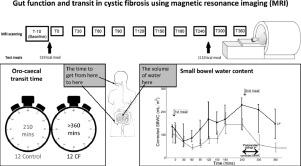Journal of Cystic Fibrosis ( IF 5.2 ) Pub Date : 2020-06-16 , DOI: 10.1016/j.jcf.2020.06.004 Christabella Ng 1 , Neele S Dellschaft 2 , Caroline L Hoad 2 , Luca Marciani 2 , Lu Ban 3 , Andrew P Prayle 1 , Helen L Barr 4 , Anke Jaudszus 5 , Jochen G Mainz 6 , Robin C Spiller 7 , Penny Gowland 2 , Giles Major 7 , Alan R Smyth 1

|
Background
Cystic fibrosis (CF) is a multi-system genetic disorder affecting >72,000 people worldwide. Most CF patients experience gastrointestinal symptoms and can develop complications. However, the mechanisms of CF gut disease are not well understood. We evaluated gut function and transit in CF using magnetic resonance imaging (MRI). We hypothesised oro-caecal transit time (OCTT) is longer in CF; with lower small bowel water content (SBWC).
Methods
Twelve CF patients aged 12–40 years and 12 age and sex-matched controls underwent serial MRIs over 1 day with standardised meals. The primary endpoint was OCTT, assessed by the appearance of a food bolus in the caecum. Other measures included corrected SBWC and corrected colonic volume (both area under the curve, AUC), gastric half-emptying time and gastrointestinal symptoms.
Results
OCTT was longer in CF (CF 330 mins [270, >360] vs. controls 210 mins [173, 315], p = 0.04), with no difference in gastric half-emptying times. Corrected SBWC was higher in CF (CF 62 L.min/m2 [36, 80] vs. controls 34 L.min/m2 [28, 41], p = 0.021); minimal postprandial decrease between T240 and T300 (CF 13 mL/m2 [-13, 57] vs. controls 102 mL/m2 [67, 108], p = 0.002) suggests impaired ileal emptying. Corrected colonic volumes were higher in CF (CF 186 L.min/m2 [167, 206] vs. controls 123 L.min/m2 [89, 146], p = 0.012). There were no differences in gastrointestinal symptoms.
Conclusions
MRI provides novel insights into CF pathophysiology. Sub-clinical ileal obstruction may be more prevalent than previously thought. Gastrointestinal MRI shows promise as an investigational tool in CF.
中文翻译:

通过磁共振成像评估胃肠功能的餐后变化和囊性纤维化的转变
背景
囊性纤维化 (CF) 是一种多系统遗传性疾病,影响全球超过 72,000 人。大多数 CF 患者会出现胃肠道症状并可能出现并发症。然而,CF 肠道疾病的机制尚不清楚。我们使用磁共振成像 (MRI) 评估了 CF 中的肠道功能和转运。我们假设 CF 中的口盲肠传输时间 (OCTT) 较长;具有较低的小肠含水量(SBWC)。
方法
12 名年龄在 12-40 岁之间的 CF 患者以及 12 名年龄和性别匹配的对照患者在 1 天内接受了连续 MRI 检查,并接受标准化膳食。主要终点是 OCTT,通过盲肠中食物团的出现进行评估。其他指标包括校正的 SBWC 和校正的结肠体积(曲线下面积,AUC)、胃半排空时间和胃肠道症状。
结果
CF 组的 OCTT 较长(CF 330 分钟 [270, >360] 对比对照组 210 分钟 [173, 315],p = 0.04),胃半排空时间没有差异。CF 中的校正 SBWC 较高(CF 62 L.min/m 2 [36, 80] 对比对照组 34 L.min/m 2 [28, 41],p = 0.021);T240 和 T300 之间的餐后最小下降(CF 13 mL/m 2 [-13, 57] 对比对照组 102 mL/m 2 [67, 108],p = 0.002)表明回肠排空受损。CF 的校正结肠体积较高(CF 186 L.min/m 2 [167, 206] 对比对照组 123 L.min/m 2 [89, 146],p = 0.012)。胃肠道症状没有差异。
结论
MRI 为 CF 病理生理学提供了新的见解。亚临床回肠梗阻可能比以前认为的更为普遍。胃肠道 MRI 显示出作为 CF 研究工具的前景。


























 京公网安备 11010802027423号
京公网安备 11010802027423号